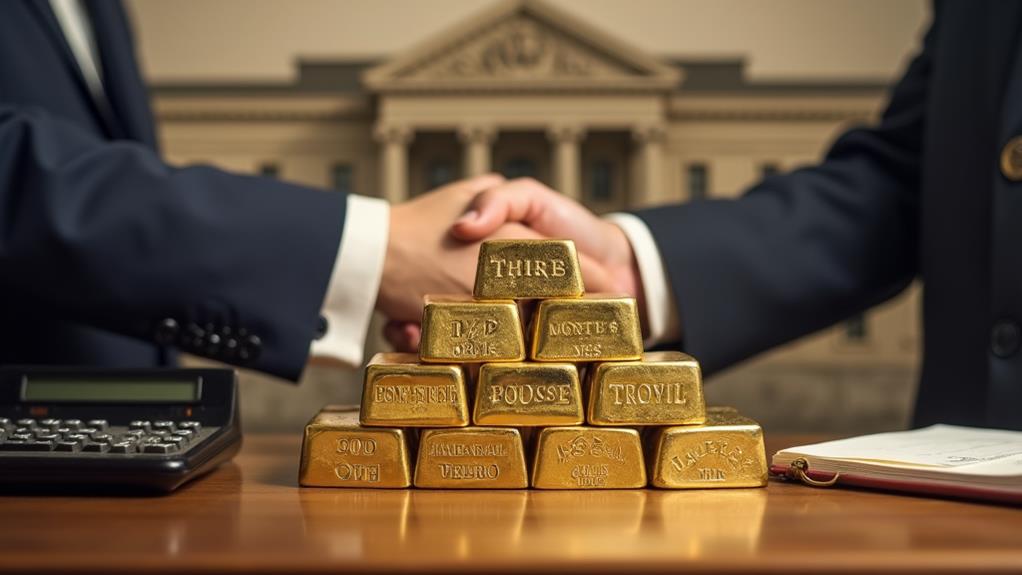Gold's voyage as an investment asset is a tale of transformation, marked by crucial moments that have shaped its role in the global economy. From its reign as the foundation of monetary systems to its current status as a safe-haven asset, gold has weathered economic storms and policy shifts. Understanding these essential milestones provides invaluable insight into the factors that influence gold's value and investors' perceptions. As we examine the historical events that have defined gold investing, we'll uncover the complex interplay between government policies, economic crises, and market innovations that continue to impact this precious metal's significance in modern portfolios.
Key Insights
- Gold Standard era linked currencies to gold, establishing its role in the global monetary system.
- The 1933 U.S. gold confiscation reshaped gold ownership and influenced long-term perceptions of its value.
- Nixon's 1971 suspension of dollar-gold convertibility ended the Bretton Woods system, causing gold prices to soar.
- Legalization of private gold ownership in 1974 marked a significant shift in U.S. monetary policy.
- Introduction of Gold ETFs in the early 2000s provided easier accessibility for retail investors.
The Gold Standard Era

The Gold Standard Era kicked off in the late 19th century, marking a significant period in global economic history. This system linked currencies to gold, ensuring stability and facilitating international trade.
Crucial milestones include:
- 1919: Creation of the London Gold Fixing
- 1925: Gold Bullion Act in the UK
- 1933: End of the gold standard in the U.S.
- 1944: Bretton Woods Agreement
The Bretton Woods system established gold backing of the U.S. dollar, with other currencies pegged to the dollar.
Nonetheless, economic pressures led to significant changes:
- 1971: Gold removal from Bretton Woods system
- 1974: Gold price controls lifted
These events transformed the global monetary landscape, shifting from gold-backed currencies to fiat money.
While gold certificates were once common, modern currency systems rely on government regulation and economic factors rather than precious metal reserves.
Great Depression and Gold Confiscation
During the Great Depression, the United States government took drastic measures to shore up its financial system, including a controversial move that sent shockwaves through the gold investment world.
In 1933, President Franklin D. Roosevelt issued Executive Order 6102, mandating the confiscation of gold from private citizens. This unprecedented action required Americans to surrender their gold bullion, coins, and certificates to the Federal Reserve in exchange for paper currency at a fixed rate of $20.67 per ounce.
The government's aim was to increase its gold reserves and combat deflation by raising the gold price to $35 per ounce. This sudden shift in policy drastically altered the landscape of gold ownership and investment.
Many viewed gold as a store of value and hedge against high inflation, making the confiscation particularly contentious. The event remains a significant chapter in the history of gold, influencing investors' perceptions of its value and government intervention for decades to come.
Bretton Woods System

Following World War II, a landmark agreement known as the Bretton Woods System reshaped the global monetary landscape. This milestone in financial history established a fixed exchange rate system, with the U.S. dollar as the world's primary reserve currency. Under this arrangement, the dollar was pegged to gold at $35 per ounce, and other currencies were tied to the dollar.
The Bretton Woods System aimed to stabilize international monetary relations by making the U.S. dollar convertible into gold for foreign central banks. This arrangement required the United States to maintain substantial gold reserves to back its currency.
While the system initially provided stability to the global economy, it faced increasing pressure as U.S. gold reserves dwindled. Eventually, in 1971, President Nixon suspended the dollar's convertibility into gold, effectively ending the Bretton Woods era and ushering in a new phase of floating exchange rates.
Nixon Shock
The Nixon Shock, occurring in 1971, marked the end of the Bretton Woods system and the abandonment of the gold standard by the United States.
President Richard Nixon's decision to suspend the dollar's convertibility to gold had far-reaching implications for global economic policy.
This move ushered in a new era of floating exchange rates and fundamentally altered the international monetary system, significantly impacting gold's role in the global economy.
End of Bretton Woods
On August 15, 1971, President Richard Nixon delivered a televised address that would fundamentally alter the global monetary system. This announcement, known as the "Nixon Shock," effectively ended the Bretton Woods agreement, which had pegged the U.S. dollar to gold at a fixed rate of $35 per ounce.
The decision to suspend the dollar's convertibility to gold led to significant changes in the global financial landscape:
- Gold prices soared, reaching a peak of $850 per ounce in 1980
- The gold futures market developed rapidly
- Investors increasingly viewed gold as an alternative to the dollar
- Central banks reassessed their gold reserves
The end of Bretton Woods sparked a gold investment boom in the 1970s, as investors sought to protect their wealth against inflation and currency fluctuations.
Despite subsequent price volatility, gold maintains its status as a safe-haven asset.
Gold Standard Abandoned
As President Richard Nixon addressed the nation on August 15, 1971, he set in motion a series of events that would permanently alter the global financial landscape. The decision to abandon the gold standard marked a crucial moment in economic history, severing the link between the U.S. dollar and gold.
This move, known as the "Nixon Shock," had far-reaching consequences for global exchange rates and the demand for gold.
With the gold standard abandoned, the price chart for the precious metal began to fluctuate more freely. Nations were no longer required to maintain specific gold reserves, leading to increased investment in gold as a hedge against economic uncertainty.
The historical performance of gold as a safe-haven asset gained prominence, with investors adding portfolio to gold allocations to preserve value over time. This shift in monetary policy fundamentally changed how markets viewed gold's role in the global financial system.
Economic Policy Implications
Following the Nixon Shock, economic policies worldwide underwent significant transformations. The abandonment of the gold standard led to a shift in how nations managed their currencies and monetary systems.
Unlike the gold rush of 1849 or the establishment of the gold bullion depository at Fort Knox, this change was not about physical gold but its role in global finance.
Countries gained more flexibility in their economic policies, no longer constrained by gold reserves. This shift impacted gold certificates, the stock market, and precious metal valuations.
The World Gold Council notes that central banks adjusted their approaches to gold holdings.
The introduction of gold exchange-traded funds (ETFs) in 2003 further changed investment landscapes. Gold futures became more prominent, reflecting a new era where gold's value was less tied to ancient practices like gold coinage in Rome.
Legalization of Private Gold Ownership

Prior to 1933, the United States operated under a gold standard, allowing citizens to freely own and trade gold.
Nevertheless, Executive Order 6102, issued by President Franklin D. Roosevelt during the Great Depression, prohibited private gold ownership, requiring citizens to surrender their gold to the government.
This restriction remained in place until 1974, when President Gerald Ford signed legislation restoring Americans' right to own gold, marking a significant shift in U.S. monetary policy and personal financial freedom.
Pre-1933 Gold Standard
The United States' adherence to the gold standard before 1933 allowed citizens to freely own and trade gold. During this period, the U.S. dollar was directly linked to a fixed amount of gold, with $20.67 equating to one ounce of gold. This system provided stability to the currency and allowed for easy conversion between paper money and physical gold.
Citizens could hold their wealth in various forms:
- Gold coins: Minted by the U.S. government
- Gold certificates: Paper currency backed by gold reserves
- Gold bullion: Bars or ingots of pure gold
The Treasury Department maintained substantial gold reserves to support this system.
Nevertheless, the fixed gold prices limited the government's ability to adjust monetary policy during economic crises. This rigidity ultimately led to the abandonment of the gold standard in 1933, marking a significant shift in U.S. monetary policy and private gold ownership.
Executive Order 6102
Executive Order 6102, signed by President Franklin D. Roosevelt on April 5, 1933, marked a significant milestone in gold investing history. This order required American citizens to surrender their gold coins, bullion, and gold certificates to the Federal Reserve in exchange for paper currency at a fixed rate of $20.67 per ounce.
Key points of Executive Order 6102:
- Prohibited the hoarding of gold coins, bullion, and certificates
- Required individuals to turn in gold to the Federal Reserve
- Set penalties for non-compliance, including fines and imprisonment
- Aimed to increase gold reserves and stabilize the economy
- Exempted certain gold holdings for industrial and artistic use
The order significantly impacted gold investments and prices, reducing private gold ownership and altering the future of gold demand.
While controversial, it played a vital role in shaping U.S. monetary policy during the Great Depression and beyond.
1974 Ownership Restoration
America's ban on private gold ownership came to an end on December 31, 1974, when President Gerald Ford signed legislation that effectively repealed Executive Order 6102. This restoration of ownership rights marked a significant milestone on the road to modern gold investing. The ability to buy gold freely opened up new opportunities for investors, leading to the development of various gold investment vehicles.
| Gold Investment Options | Advantages | Considerations |
|---|---|---|
| Physical Gold | Tangible asset | Storage, security |
| Gold IRAs | Tax benefits | Fees, regulations |
| Gold ETFs | Easy trading | No physical ownership |
The launch of gold exchange-traded funds (ETFs) and gold trusts in the early 2000s further expanded access to gold investments. These instruments, along with digital gold platforms, have made it easier for individuals to invest in gold without the need for physical storage.
Gold ETFs Emerge
A significant development in gold investing occurred in the early 2000s with the introduction of gold exchange-traded funds (ETFs).
These financial instruments allowed investors to gain exposure to gold without physically owning the metal. The SPDR Gold Trust, launched in 2004, became the first and largest gold ETF, followed by others like iShares Gold Trust.
Gold ETFs offered several advantages:
- Easier accessibility for retail investors
- Lower storage and insurance costs
- Improved liquidity compared to physical gold
- Potential tax benefits in some jurisdictions
- Ability to track gold prices closely
Gold ETFs quickly gained popularity among investors seeking to diversify their portfolios.
Nevertheless, it is essential to note that while these funds aim to mirror gold's performance, they may not always perfectly reflect the metal's price movements.
Investors should carefully consider the profitability and performance of gold ETFs in relation to their investment goals and risk tolerance.
Global Financial Crisis Impact

The global financial crisis of 2007-2008 had a profound impact on gold investing, triggering a surge in demand for the precious metal. As economic uncertainty gripped markets worldwide, investors sought safe-haven assets, propelling gold prices to unprecedented levels.
During this period, spot gold breached multiple barriers, with gold prices breaking record highs repeatedly. The surge in gold prices reflected growing concerns about the stability of traditional financial instruments and currencies.
Key developments:
- Gold hit an all-time high of $1,920.30 per ounce in September 2011
- Gold rises back to year high on safe-haven buying amid market volatility
- Investors flocked to gold ETFs, driving assets under management to new heights
The global financial crisis solidified gold's reputation as a store of value during times of economic turmoil, influencing investment strategies and portfolio allocations for years to come.
My Final Thoughts
Gold's odyssey from currency standard to investment asset is a testament to its enduring allure. Like a phoenix rising from economic ashes, gold has repeatedly proven its resilience. The milestones in gold investing history illuminate the metal's evolving role in the global financial landscape. As markets continue to fluctuate, understanding this history becomes essential for investors navigating the complex waters of modern economics, with gold serving as a potential anchor in turbulent times.







